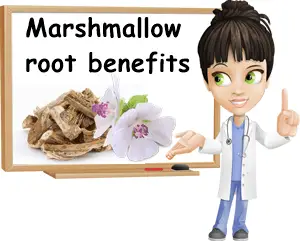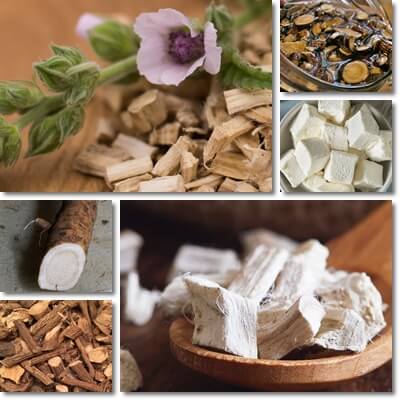Did you know that the light, fluffy, spongy, gooey marshmallows so many of us love used to be made from a plant? While not anymore, the original ingredient in marshmallow confectionery was Althaea officinalis root.
The plant is more commonly known as the marshmallow plant, and its root has so many wonderful benefits and uses. Marshmallow root is successfully used for acid reflux disease, gastritis and peptic ulcers, heartburn, cough and sore throat, dry skin, skin irritation and small wounds, but also bladder inflammation in interstitial cystitis, urinary tract infections, water retention, IBS and other inflammatory digestive conditions causing diarrhea and constipation.
What does marshmallow root look like?
Marshmallow roots are long and tapering, off white or cream colored on the inside, with a cream to yellowish brown bark on the outside, depending on the age of the root. The best roots are older ones because they are thicker and provide the most product, but younger, more slender ones can be used just the same and provide the same range of benefits. Marshmallow root is fibrous, woody and tough which is why it is used dried and ground or cut into small pieces.
The roots are perennial, meaning they live longer than 2 years and grow thicker with each year.

What does marshmallow root taste like?
Marshmallow root has an earthy taste. When used to make tea for calming cough, soothing a sore throat, calming IBS or other digestive discomfort, or for interstitial cystitis, gastritis and peptic ulcer upset, the taste of marshmallow root is reported to be either dull or faintly sweet, but really barely flavored, or slightly unpleasant, with an unpalatable, but light bitter aftertaste (likely from the amino acid asparagine).
The ground root, taken plainly, as a dietary supplement, may be particularly unpleasant in taste and smell for those that do not like the plant. Some people will like it, while others just won’t.
What does marshmallow root do?
Marshmallow root is an important natural source of mucilage, a sticky, viscous substance that forms a protective coating over mucous membranes (throat, esophagus, digestive tract lining) and skin, relieving inflammation and pain. Mucilage is one of the main biologically active compound in the root and one of the sources of most of its health benefits and uses.
The average content of mucilage is 10%. The root further contains starch (between 35% and 40%) with binding properties, contributing to the demulcent properties of the plant preparations. Lastly, pectin, a soluble dietary fiber, has gelling properties and helps maintain structure, also contributing to the soothing properties of the plant. The pectin content is around 10%, similar to mucilage.
Properties and biologically active compounds
Most of the benefits of marshmallow root are a result of three main naturally-occurring compounds: mucilage, pectin and starch. Mucilage is good for relieving irritation, inflammation and pain. It acts by coating mucous membranes, forming a protective layer that helps reduce irritation, lower inflammation and soothe pain. Pectin binds, softens and soothes. Starch also has binding and stretching properties. Other compounds in the root with potential benefits include antioxidants such as flavonoids, poly-phenolic compounds, amino acids such as asparagine (also responsible for the bad taste and smell).

How to use marshmallow root
- The fresh root can be cleaned and cut into small pieces, shaved or finely ground and steeped in hot water to make marshmallow root tea (boiling is not recommended), or steeped in cold water for several days to make a maceration for internal use (the liquid is more commonly used).
- Ground and dried marshmallow root is encapsulated to make dietary supplements. The average content of marshmallow root per capsule is 480 mg and the recommended dosage is 2 capsules a day.
- Bags of the ground and dried root are available to buy online or in health food stores. The ground and dry root can be taken as such as a dietary supplement or medicinal herbs for various ailments, used to make tea, a maceration or mixed with water or other products for topical use.
- A water-based tincture can be made from the roots or leaves of the plant, or both, and has internal and external uses. It can be taken as such or mixed with water, other liquids, food or other plant products, depending on the intended use.
Whatever your choice of product, make sure to read the label. Look for information regarding the purity of the product – some marshmallow products may only contain the root, others may have other ingredients, including but not limited to: leaf extract, gelatin, glycerin, Aloe Vera, other herbal extracts, water, preservatives such as sodium benzoate, flavor additives etc. Also check to see if the product is from organic agriculture.
What are the benefits Of Marshmallow Root?
Few uses for marshmallow root have been scientifically proven (read: systematically evaluated). At least part of the recommendations on how to use the root and preparations made from it and the reports on their effectiveness are purely anecdotal. However, this does not mean Althaea officinalis preparations are not good for certain conditions or just as effective as some medication, if not more. With this is mind, here are the top 12 benefits of the plant:
- Marshmallow root tea soothes sore throat inflammation and temporarily helps with irritation and pain. Good to use for sore throat caused by respiratory tract infections, viral or bacterial (common cold, flu, tonsillitis, strep throat etc.), or by gastroesophageal reflux disease.
- Good for cough. The tea calms cough, helping reduce throat irritation, as well as thins throat mucus and helps get rid of throat phlegm buildup.
- Benefits for heartburn. The mucilage and other bioactive compounds in the plant root form a protective coating over the esophagus lining, temporarily calming soreness, inflammation and the burning sensation caused by heartburn. Tea, tinctures, supplements or the plain ground root may be used.
- Good for acid reflux, gastritis and peptic ulcers. Marshmallow root reduces stomach acid production in GERD (gastroesophageal reflux disease) and gastritis, promoting healing of existing ulcers in the lining of the esophagus, stomach and small intestine. Tea, tinctures, supplements or the plain ground root may be used.
- Potential benefits for inflammatory bowel conditions such as IBS (irritable bowel syndrome). The mucilage and anti-inflammatory properties of the plant promote healing and soothe pain.
- Diuretic properties. Marshmallow root is a diuretic and can cause frequent urination and increased urine output. The diuretic properties could hold benefits for UTI (urinary tract infections) treatment and possibly also water retention and leg and ankle swelling, face puffiness.
- Potential benefits for the kidneys. The plant’s diuretic properties encourage the elimination of kidney stones.
- Marshmallow root and interstitial cystitis. Interstitial cystitis (IC) is an inflammatory condition of the bladder. Marshmallow root may help reduce inflammation and improve symptoms associated with IC such as frequent urination, urgency to urinate and discomfort and pain.
- Marshmallow root for diarrhea and constipation. For diarrhea, the pectin binds loose stools, while the mucilage relieves irritation and pain associated with frequent stools. For constipation, the pectin increases viscosity and adds volume to stools and, together with the mucilage, softens hard stools, stimulates peristalsis and promotes the easy passing of bowel movements.
- Lowers blood sugar. The root and its by-products have been found to lower blood sugar levels.
- Benefits for skin. The tincture, ground root mixed with water or various skin-care products can be applied to the skin to soften skin, relieve dryness, reduce swelling and calm irritation and pain. Uses include: dry, rough skin, insect bites, small cuts, bruises, burns, cracks in the skin etc.
- Marshmallow root for hair. The plant extract is commonly used for hair detangling, although its effectiveness is questionable. Some people use it for dry, brittle, dull, lifeless hair, to reduce hair breakage, restore shine and flexibility. Mixed with various hair products such a gels or mousse, it is good for improving hold and maintaining curls.
What are the side effects Marshmallow Root ?
People report conflicting results after taking marshmallow root supplements. Here are potential side effects associated with Althaea officinalis supplements and other preparations:
- Not only do they not help with urgency, but they may actually cause more urgency for those with bladder issues such as interstitial cystitis, increase pressure or flare up the condition. Indeed, the plant also has diuretic properties which may explain these side effects.
- One of the biggest dangers or marshmallow root is it can cause allergic reactions, although it’s not a common allergen. Mild: skin rash, itching and redness, digestive upset. Severe: anaphylactic shock – if you experience wheezing, tongue or throat swelling, airways closing, seek medical help immediately!
- May cause digestive upset in some people. For example, constipation, diarrhea, stomach hurt etc. Discontinue use immediately and see a doctor.
- Causes low blood sugar. May interact with blood sugar-lowering medication, so talk to your doctor first if you have diabetes.
- Reduces blood coagulation, thinning blood. This may constitute a serious side effect for some people. The plant should be discontinued before surgery and use avoided by anyone receiving blood thinning medication.
- May interact with medication, either increasing or decreasing their effectiveness (example: diuretic, antibiotics, diabetes medication for lowering blood sugar, blood thinners).
- The supplements may be hard to swallow – but this side effect has more to do with the manufacturer’s choice of capsule composition than the plant itself. Personal tip: have a gulp of water first, then immediately proceed to swallow the pill/capsule/tablet.
- Smells bad and tastes bad – nasty, awful, horrible. A solution would be to air out the capsules you’re about to take by taking them out of the bottle and leaving them out on the table for 15-30 minutes. The same solution could work for the ground root powder.
- Some people just don’t see any benefits from taking marshmallow root. But this is to be expected since not everyone reacts the same way to the same food, medicine or herb.
